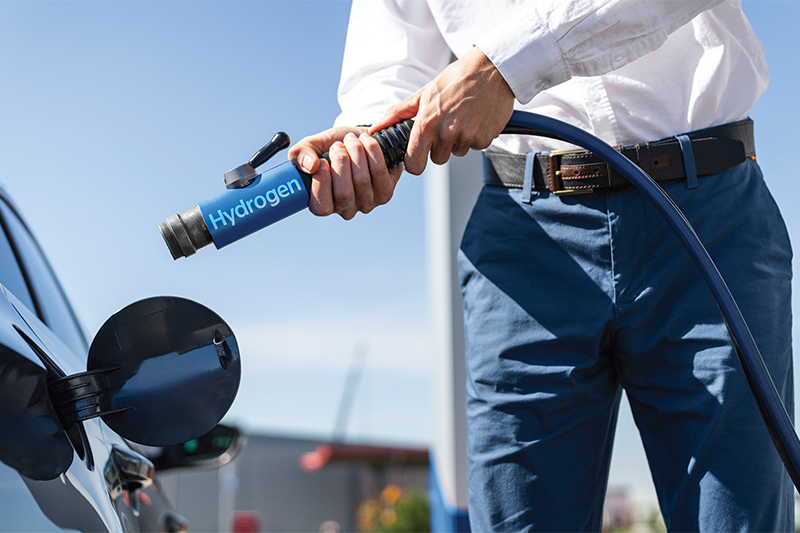The role of hydrogen in the future of motoring

Alan Outhwaite, head of the Verification of Lubricant Specifications (VLS) Technical Review Panel, spells out his view on what role hydrogen will have in the net zero transition.
The race to net zero has been on for some time. EVs were seen as the answer, with OEMs developing hybrid and BEVs to meet emissions targets. Hydrogen was also being explored as a potential solution – both in fuel cell operation and in combustion engines.
How do hydrogen vehicles actually work?
There are two main types of hydrogen-propelled vehicles: a hydrogen fuel cell and a hydrogen-fuelled vehicle, and they both work in different ways.
A hydrogen-fuelled vehicle replaces conventional road fuel with compressed hydrogen gas or liquid. In these vehicles, the pressurised gas or liquid is injected directly into an engine’s combustion chamber, and combustion takes place as per a conventional fuelled engine. The primary emission from hydrogen combustion is water, a property that makes it an environmentally attractive fuel.
Most modern ICE designs wouldn’t require much modification to run on hydrogen gas or liquid, but durability has not been proven in these systems, and appropriate lubricants are needed. These need to be formulated to minimise the potential for pre-ignition events, as well as manage increased levels of water in the crankcase to prevent corrosion, sludge formation and reduce wear. Service stations could be converted to dispense hydrogen gas or liquid with extensive changes required, and refuelling will take as much time as conventional fuels.
Specific engine management and filters can remove airborne contaminants, like nitrous oxide and sulphur oxides, present due to the air intake for combustion to unmeasurable levels of emissions. The hydrogen gas is less dense than petrol or diesel, and the by-product of the combustion process is water vapour. Of note is that the combustion of hydrogen generates more than four times as much water as that of diesel, reinforcing the need for specialist lubricant formulations to manage emulsion formation and corrosion.
In a hydrogen fuel cell, instead of burning hydrogen gas, as is the case with hydrogen ICE-fuelled vehicles, the vehicle produces electricity through a chemical reaction between hydrogen from the storage tank and oxygen from the air in something called a ‘fuel cell stack’.
The stack powers the heart of the vehicle and generates electricity in the form of direct current from electrochemical reactions that take place in the fuel cell. Unlike a conventional battery, which stores electrical energy made elsewhere and releases it, hydrogen is an energy source in itself and releases some of its energy in an electrochemical reaction in the fuel cell. Electricity is then produced on demand.
Impact on motorists
The main advantage for vehicle owners is that, unlike pure EVs, refuelling a tank for a hydrogen fuel cell from a pump takes less than five minutes. In contrast to ICEs, hydrogen fuel cell vehicles require no engine lubricants, though specialist fluids are required for transmission, braking and cooling systems.
Are hydrogen vehicles a viable solution?
According to some OEMs, it is; in February this year, Toyota launched its third-generation fuel cell system (3rd Gen FC System) as part of its continued efforts toward “the realisation of a hydrogen society”. In 2024, Hyundai outlined its approach to hydrogen in its “Hydrogen Vision 2040: A roadmap toward a hydrogen society”, saying that hydrogen fuel cells are “pivotal in assessing the technological prowess of FCEVs”. Tesla also unveiled its hydrogen-powered car last year, the Model H, which is expected to debut in 2026.
The testing phase of Project Cavendish, a £9.8m government-funded programme facilitated by the Advanced Propulsion Centre UK (APC), has begun. The project is designed to drive hydrogen fuel use in existing heavy-duty truck engines with a clear path to enable hydrogen combustion using current platforms and infrastructure, accelerating the decarbonisation of the haulage sector.
In February 2025, Jonathan Hall, MAHLE Powertrain’s head of research and advanced engineering, said: “Hydrogen combustion engines are well-suited to heavy-duty, long-distance applications that are hard to electrify. Its use allows industry to take advantage of years of development and investment as a means to accelerate the transition towards net zero.”
Hydrogen generation is attracting a lot of investment in different methods. Green hydrogen is a ‘clean energy’ made using electricity from renewable energy sources, such as solar or wind power, to electrolyse water. Green hydrogen currently only makes up a small percentage of overall hydrogen production, but increased investment will help reduce costs over time, just as energy from wind power has reduced in price.
ICE not doomed
In the meantime, many motorists will hang onto their current ICE vehicles for as long as possible, as shown by the already ageing vehicle parc. For lubricant and specialist fluid manufacturers, motor factors – like you – and workshops, this means dealing with a more extensive and complex product range for the near future, catering to the needs of older vehicles as well as the latest models and a variety of powertrains. Backwards compatibility will be a critical advantage in limiting SKU counts by creating solutions for a wider range of vehicles.








